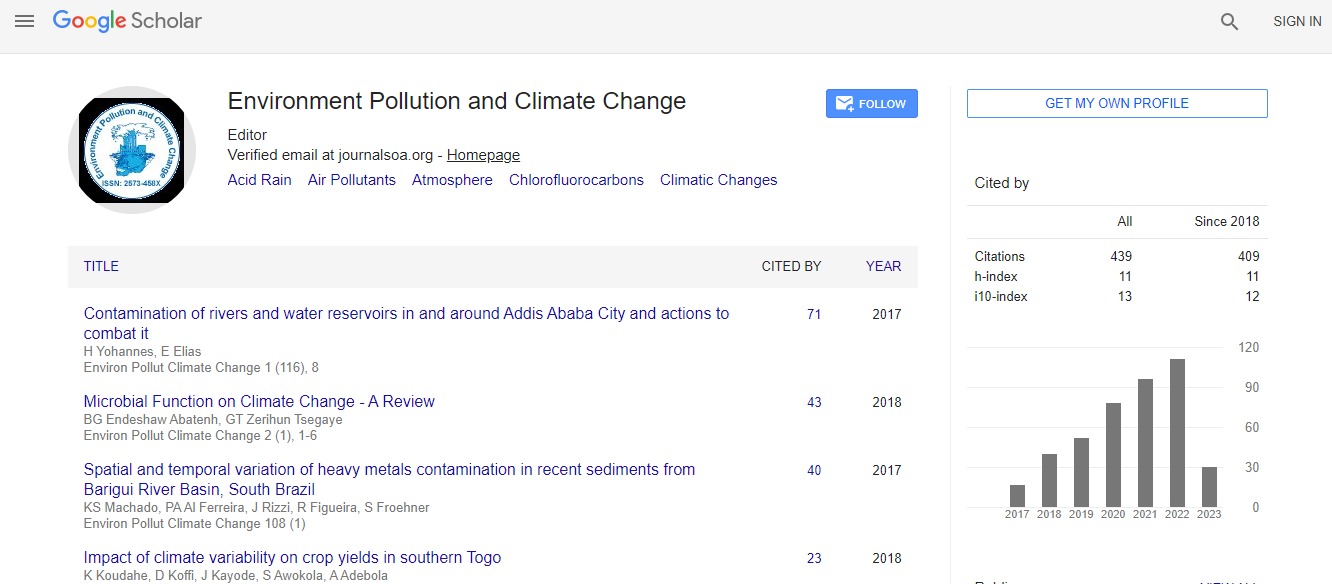Our Group organises 3000+ Global Conferenceseries Events every year across USA, Europe & Asia with support from 1000 more scientific Societies and Publishes 700+ Open Access Journals which contains over 50000 eminent personalities, reputed scientists as editorial board members.
Open Access Journals gaining more Readers and Citations
700 Journals and 15,000,000 Readers Each Journal is getting 25,000+ Readers
Google Scholar citation report
Citations : 672
Environment Pollution and Climate Change received 672 citations as per Google Scholar report
Environment Pollution and Climate Change peer review process verified at publons
Indexed In
- Google Scholar
- Publons
- Euro Pub
- ICMJE
Useful Links
Recommended Journals
Share This Page
Microplastics and associated chemicals: methods, interactions, and perspectives
Global Summit on Environmental Health
Virginia Fernandes
Instituto Superior de Engenharia do Porto, Portugal
ScientificTracks Abstracts: Environ Pollut Climate Change
Abstract
Plastic has been a fundamental material in modern society and every year more than 300 million tonnes are produced. Plastics contain in their composition one or more polymers and other chemicals, that, when degraded (through various biotic and abiotic processes), generate microplastics and associated chemicals (MP/AC) released in various compartments, raising concerns about their negative impacts on the environment and human health (1-2). The polarity of the MP surface enables interactions (sorption and desorption) with surrounding AC that can be facilitated in environments where plastics are degraded by UV radiation and temperatures. Moreover, MP aging reduces the hydrophobicity of plastics thereby increasing their sorption capacity for hydrophilic contaminants (3). Therefore, MP can be a vehicle for AC, namely, additives such as plasticizers, flame retardants, stabilizers, and sorbed contaminants such as metals, polychlorinated biphenyls (PCB), pesticides, and polycyclic aromatic hydrocarbons (PAH) (3-4). MP have become ubiquitous and detected in marine and freshwater, soils, air, food, and several species including humans (1). Studying microplastics is very complex as there are many factors to account for, such as differences in particle sizes, constituents, shapes, additives and contaminants, concentrations, and many more. To address these issues, reliable information on the assessment of MP/AC is crucial. However, the analytical methodologies used to identify/quantify MP/AC are relatively limited and not uniform/standardized, and the complexity of comparing experimental setups and data reporting is a critical issue (5). Moreover, the consequences of body exposure to MP/AC are not well understood, and consequently, information is missing for a thorough risk assessment and development of new strategies.Biography
Virgínia has a degree in chemistry; Master degree in environmental sciences and PhD in chemistry (2012). She is Post-Doc Researcher at REQUIMTE/LAQV – Instituto Superior de Engenharia do Porto do Instituto Politécnico do Porto (ISEP). She published 42 publications in international peer journals and 7 book chapters. Virgínia has been involved in 18 R&D projects (11 national and 7 international). She has supervised 2 PhD, 19 MSc and 9 BSc and she has given invited lessons in BSc and MSc from ISEP and Nova Medical School. Her nuclear scientific area is analytical chemistry namely extraction and analysis of pesticides and other contaminants in food, environmental and human samples. Her research addresses all aspects of the analytical process and data processing using many types of analytical techniques applied in novel and useful ways. Her interests also extend to toxicology, human health and nutrition (http://orcid.org/0000-0003-3979-7523).

 Spanish
Spanish  Chinese
Chinese  Russian
Russian  German
German  French
French  Japanese
Japanese  Portuguese
Portuguese  Hindi
Hindi 
